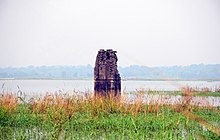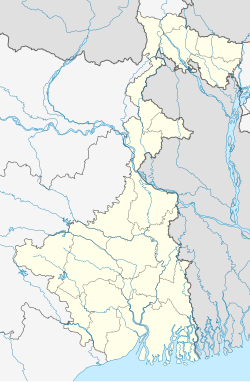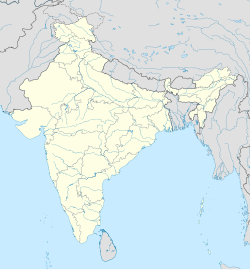Telkupi
 A submerged deul at Telkupi | |
| Location | Raghunathpur subdivision, Purulia district |
|---|---|
| Region | West Bengal, India |
| Coordinates | 23°39′59″N 86°36′24″E / 23.666362°N 86.606561°E |
| Type | Ancient Settlement |
| History | |
| Builder | Rudrasikhara |
| Founded | 11th century |
Telkupi is a submerged archaeological site in Purulia district in the Indian state of West Bengal. The area, along with most of the temples situated there, was completely submerged in 1959 as a consequence of the construction of a dam across Damodar river at Panchet in Dhanbad district, then in Bihar.
Ancient history
Telkupi, then named, Tailakampi,[1] is known to be the capital of Rudrasikhara, a local ruler of the area in 11th century, who helped Pala king, Ramapala to recover Varendra from Bhima. The royal chronicle of Panchkot Raj of Shikhar dynasty mentions that Rudrashikhara rose in power in 1098 AD.[1]: 223 Historian Niharranjan Ray assumes that he ruled from 1070 to 1120.[2] Sandhyakar Nandi in his poem Ramacharitam comments that like wildfire, Rudrasikhara, expert in warfare, crushed the pride of the rulers of the rivers and mountains.[3]
Temples
Description by Beglar
In 1878, Joseph David Beglar first described thoroughly about the temples of Telkupi in his report for Archaeological Survey of India.[4]: 6 According to him, the place was full of finest temples and the number was highest among any places in the Chota Nagpur Plateau. The temples were divided into three clusters, the largest group among them was situated in the north of Telkupi village near the Damodar river, the second group in the west of the village and the third group in the south-eastern part of the village.[5]: 170
First group of temples
- No. 1: This south-facing temple, made of stone, was situated in the northernmost part of the first cluster, consisting of a single cell, with a lingam as the deity of worship inside, situated 2 feet below the still of entrance. The temple was not much ornamented. Beglar noticed that the upper part of the temple was almost intact.[5]: 170
- No. 2: This south-facing stone-made temple had a sculpture of Gajalakshmi over the entrance, with a lingam inside. Beglar found the upper portion of the temple broken and accumulated sand in the cell rose 6 inches of the still of entrance.[5]: 170
- No. 3: This west-facing temple, with a lingam inside, was similar to No. 2 temple but Beglar found the upper portion missing and the sill of the entrance buried four feet below accumulated rubbish.[5]: 170
- No. 4: This east-facing almost-ruined temple had a sculpture of lotus over the entrance and a well-preserved four-armed statue of Vishnu was inside the temple as the deity of worship.[5]: 170
- No. 5: This east-facing temple, had a sculpture of Ganesha over the entrance. Beglar found the upper portion of the temple missing.[5]: 170
External links
 Garh Panchakot travel guide from Wikivoyage - It includes Telkupi
Garh Panchakot travel guide from Wikivoyage - It includes Telkupi
References
- ^ a b Basu, Nagendranath (2004). Chowdhury, Kamal (ed.). Banger Jatiyo Itihas, Rajanya Kanda (in Bengali). Kolkata: Dey's Publishing.
- ^ Ray, Niharranjan (1976). Banglar Itihas (in Bengali). Kolkata: Lekhak Samabay Samity. p. 251.
- ^ Nandi, Sandhyakar (1934). Vidyavinod, Ayodhyanath (ed.). Ramacharitamanas (in Sanskrit). Kolkata: Dibyasmriti Samiti.
samara-parisara-visarad-ari-raja-raji-ganda-garvva-gahana-dahana-davanalas-tailakampiya-kalpa-taru-[Ru]d[r]asikharah
- ^ Mitra, Debala (1969). "II". Tekupi – a submerged temple site in West Bengal. Memoirs of the Archaeological Survey of India. Vol. 76. New Delhi: Archaeological Survey of India.
{{cite book}}: CS1 maint: date and year (link) - ^ a b c d e f Beglar, Joseph David Freedone Melik (1878). "Telkupi". Report of a Tour Through the Bengal Provinces of Patna, Gaya, Mongir and Bhagalpur; The Santal Parganas, Manbhum, Singhbhum and Birbhum; Bankura, Raniganj, Bardwan and Hughli; in 1872-73. Report of the Archaeological Survey of India. Vol. VIII. Kolkata: Archaeological Survey of India.

